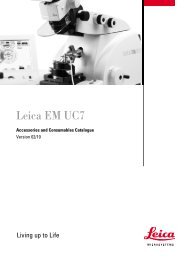Physical Principles of Electron Microscopy: An Introduction to TEM ...
Physical Principles of Electron Microscopy: An Introduction to TEM ...
Physical Principles of Electron Microscopy: An Introduction to TEM ...
Create successful ePaper yourself
Turn your PDF publications into a flip-book with our unique Google optimized e-Paper software.
Chapter 7<br />
RECENT DEVELOPMENTS<br />
7.1 Scanning Transmission <strong>Electron</strong> <strong>Microscopy</strong><br />
In Section 1.6, we noted that a field-emission S<strong>TEM</strong> was the first instrument<br />
<strong>to</strong> successfully image single a<strong>to</strong>ms in the late 1960’s. Several years later, a<br />
“dedicated S<strong>TEM</strong>” (operating only in scanning mode) was manufactured by<br />
the Vacuum Genera<strong>to</strong>rs Company in the UK. A cross-sectional diagram <strong>of</strong> a<br />
substantially modified version <strong>of</strong> this instrument (at IBM Watson Research<br />
Labora<strong>to</strong>ries) is shown in Fig. 7-1. Because there is no need for a viewing<br />
screen inside the lens column, its electron gun is located at the bot<strong>to</strong>m <strong>of</strong> the<br />
instrument (with some advantage in terms <strong>of</strong> mechanical stability) and the<br />
electron detec<strong>to</strong>rs are on <strong>to</strong>p (making it easier <strong>to</strong> modify the detec<strong>to</strong>rs or add<br />
new<br />
ones).<br />
Most S<strong>TEM</strong> images are recorded in dark-field mode, using an annular<br />
dark-field (ADF) detec<strong>to</strong>r located just above the specimen. Its design is<br />
similar <strong>to</strong> that <strong>of</strong> a Robinson or solid-state BSE detec<strong>to</strong>r used in the SEM<br />
(Fig. 5-10) but it collects electrons that are transmitted through the specimen<br />
and scattered within a certain angular range (�min <strong>to</strong> �max), determined by the<br />
inner and outer diameters. By making �min large, only large-angle (mainly<br />
elastic) scattering is collected. According <strong>to</strong> Eq. (4.15), its intensity is<br />
proportional <strong>to</strong> Z 2 . Therefore the ADF image contains strong a<strong>to</strong>mic-number<br />
contrast and not much diffraction contrast (most <strong>of</strong> the diffracted electrons<br />
have a scattering angle less than �min and pass through the central hole in the<br />
detec<strong>to</strong>r). Although the signal is weak, the annular detec<strong>to</strong>r design provides<br />
high collection efficiency, as all azimuthal angles <strong>of</strong> scattering are recorded<br />
(unlike the case <strong>of</strong> dark-field imaging in a conventional <strong>TEM</strong>).



